The Apple iPad Mini 4 Review
by Brandon Chester on October 28, 2015 8:00 AM EST- Posted in
- Tablets
- Apple
- Mobile
- iPad Mini 4
Display
When the original iPad Mini launched it came with a 7.9" 1024x768 IPS display. The third generation iPad had already existed for nearly eight months at that point, and so the display was a notable step down from the full size iPad. However, in order to drive its display the iPad 3 had to include a massive 42.5Wh battery, and was both thicker and heavier than the iPad 2 that came before it. There was simply no way to include such a display on the iPad Mini at that time.
A year went by, and Apple then launched the iPad Air and the iPad Mini 2, both of which had 2048x1536 IPS displays. Based on their specifications, one would think that the iPad Mini 2 was simply a shrunken down iPad Air. However, there was one caveat, which was the iPad Mini 2's color gamut. In order to drive down power consumption the iPad Mini 2 used an LED backlight array which didn't have the necessary spectral range to cover the sRGB color space, which gave it more muted colors than what one would see on the iPad Air's display. The following year came and went, with the iPad Mini 3 only adding Touch ID to the iPad Mini 2. At that point I began to wonder when we would finally see parity between the displays on the smaller and larger iPads.
This year's iPad Mini 4 appears to be the version that finally addresses the gap between the displays on the mini and normal size iPads. Apple claims that it has full coverage of the sRGB color space, along with the anti-reflection coating and display lamination that debuted on the iPad Air 2. Of course, anyone who has followed my tablet reviews knows that covering a color space doesn't guarantee accuracy of the colors within that space, and to examine the accuracy of the iPad Mini 4's display I've run it through our standard display testing workflow. As always, the display is calibrated to 200 nits, and measurements are performed with an X-Rite i1Pro 2 and managed with SpectraCal's CalMAN 5 software.
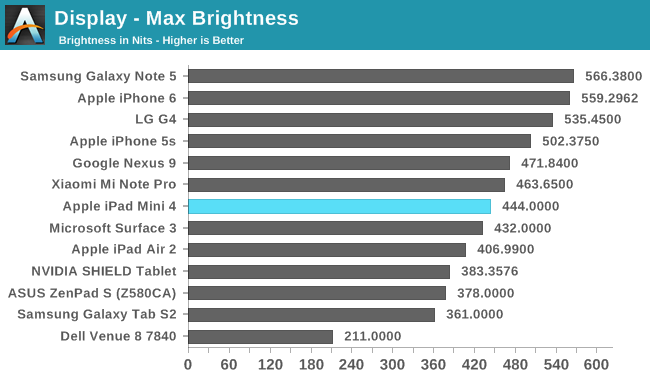
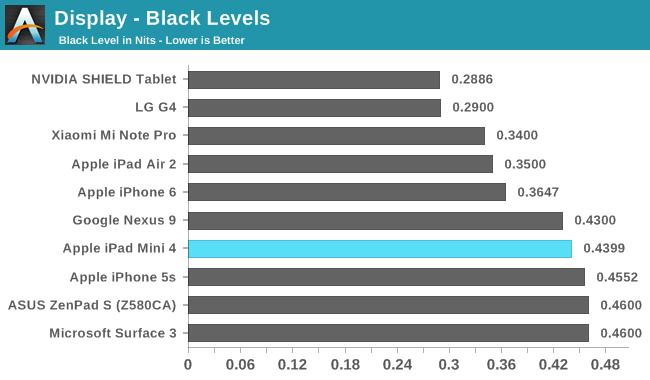
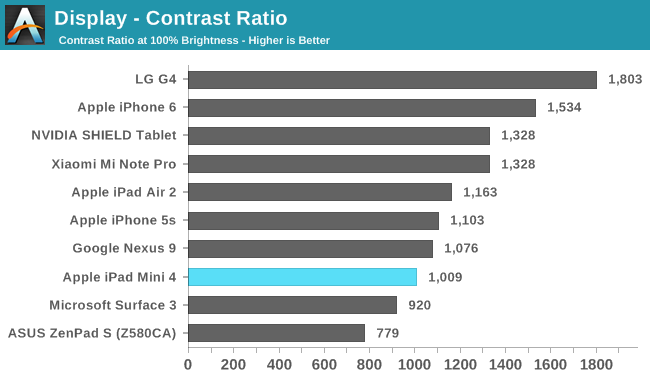
Peak brightness is surprisingly high on the Mini 4. I expected it to be more in line with the Air 2, but it's actually significantly brighter. Along with that comes higher black levels at max brightness, although if you put both at the same brightness the black levels are fairly close. The contrast ratio for the Mini 4 does fall a bit below that of the Air 2, and neither are in the same class as newer IPS LCDs on phones like the LG G4 and recent iPhones that use photoalignment to influence subpixel orientation in order to boost contrast. However, both are in line with the best you'll get on tablets without moving to an AMOLED panel with true blacks like the one on the Tab S2.
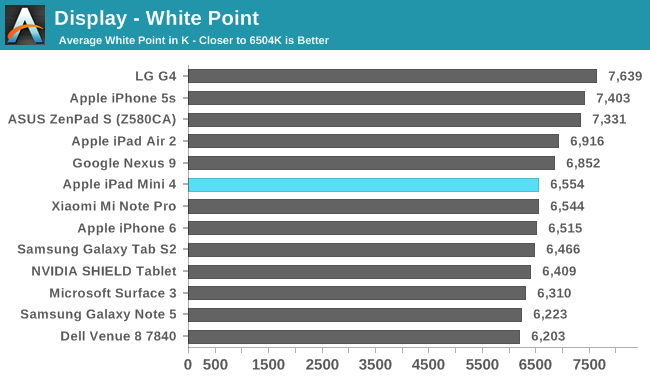
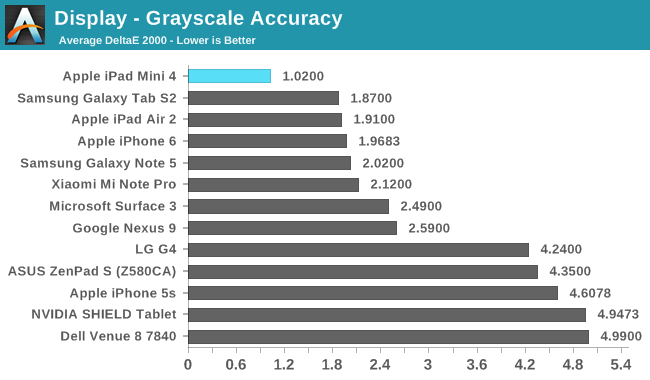
Greyscale accuracy on the Mini 4 is superb, and with almost every shade there's no way to see any errors. Once you hit 80% grey and above there is an ever so slight green tint, but it's nothing that you would really notice during everyday use, and error for the critical 100% white value is almost impossible to perceive. Gamma is also remarkably straight, and the average white point is only ever so slightly blue. I think that my unit actually tends less toward the blue than the average unit will, as in my experience iOS devices sit somewhere closer to 7000K than D6504 as the WLED backlights are more energy efficient when the display is calibrated to be slightly blue.
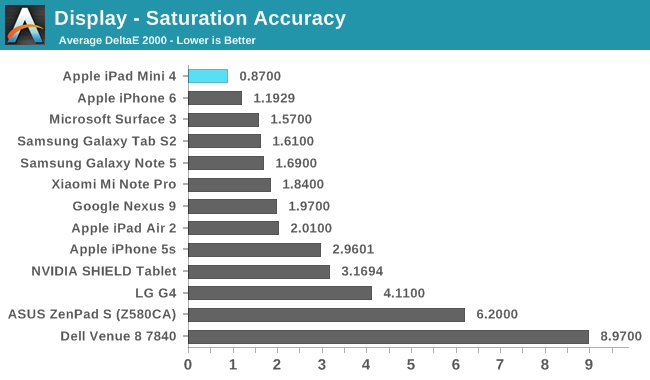
On my unit there's actually no way for the human eye to discern the difference between any of the measured saturations and the actual reference value, even if you were to put those two colors side by side. I can't imagine that this is true of all models, as achieving this level of calibration across every Mini 4 is simply not feasible. That being said, even if some Mini 4 had saturation errors that were three times higher than my result it would still be a great display and in most cases you wouldn't notice any visible errors.
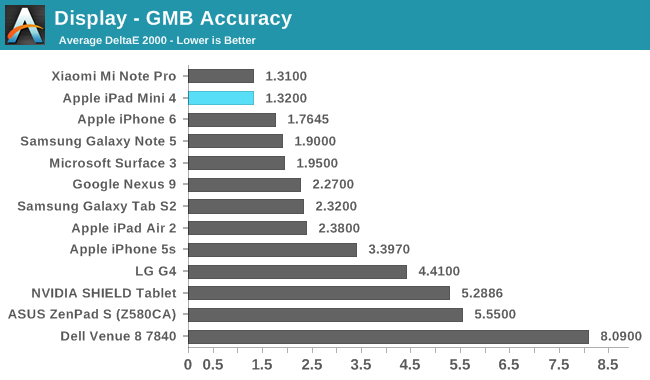
The Mini 4 shows an extremely high degree of accuracy in the Gretag-Macbeth ColorChecker test, with only a couple barely noticeable errors in shades of orange. Again, I think my unit is probably one of the better ones out there, but if the average unit is even remotely close to this then it's going to have a very accurate display for essentially any color within the sRGB gamut. There's really not much more to say, as I can't find anything about the Mini 4's display that I could honestly criticize.


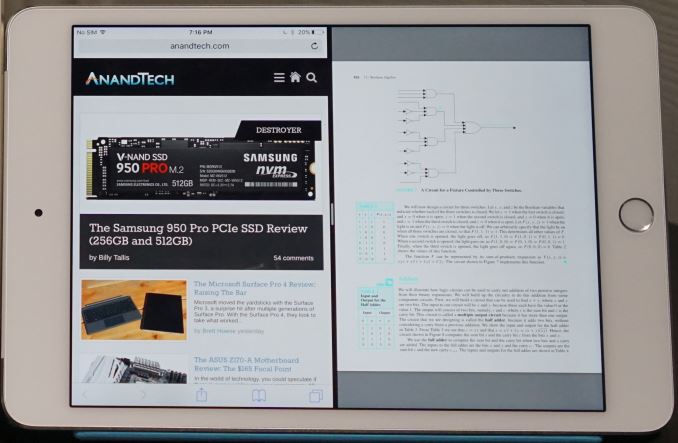



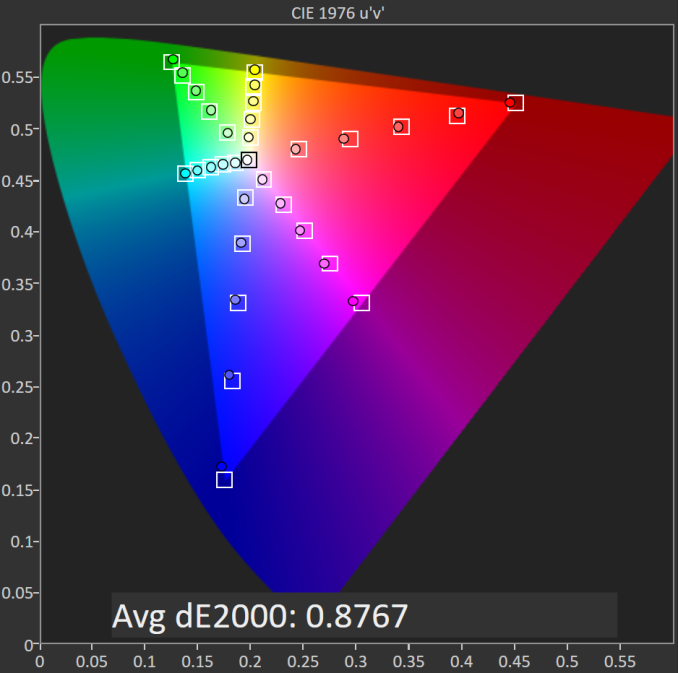
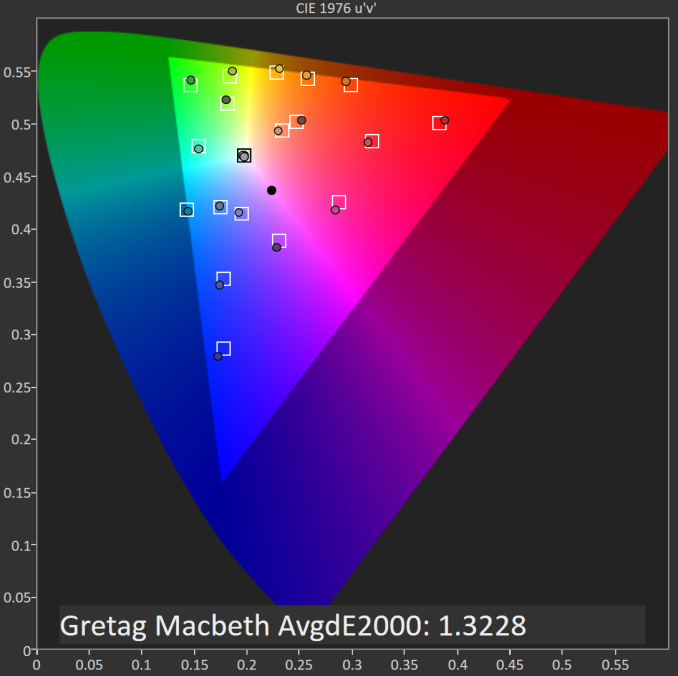









98 Comments
View All Comments
akdj - Sunday, November 1, 2015 - link
I meant to add the speed of the onboard storage and it's read write performance as well as the anti reflective coating, better color gamut and similar brightness with phenomenally accurate displays ...my guess is it's a power users dream to own a secondary display that is this mobile and this accurate with a gazillion apps that benefit the creative folkAnyway
Moving along
...there's more than just the 'A8' here that's in play and the iPod touch isn't much of a comparison.
osxandwindows - Friday, October 30, 2015 - link
No they could not produce more a9s then was necessary for the iPhones.denem - Saturday, October 31, 2015 - link
You have some inside information perhaps? The whole iPhone supply chain is set up to be able to meet demand.akdj - Sunday, November 1, 2015 - link
Hence the reason they're using two companies to fab their SoC this year? TSMC & Sammy? That's not tradition. It's very likely a contributing factorosxandwindows - Tuesday, November 3, 2015 - link
What did you want them to make 120 million of a9 chips?, come on dude even thats a hy number for samsung.akarogi - Wednesday, October 28, 2015 - link
If the iPad switch to match the ID of the iPhone 6, the rounded edges would render useless the multiple Keyboard or stand accessories that I've purchased. That hard edge on the iPad is important for stability, to be able to firmly catch the edge on whatever stand you're using.For example, the Microsoft Universal Mobile keyboard works well to prop up just about any device I own, except for the iPhone 6. The rounded edges catch just enough to hold it, but the slightest bump on the desk will send it crashing down.
Of course, manufacturers would just make new accessories for a new iPad ID, but I wonder if what I mentioned above factors into their decision to keep the existing ID. Having stability on a stand is much more critical for an iPad than for an iPhone, and iPad accessories on average will be a more significant monetary investment... so I'm quite glad my new Mini 4 still works on my keyboards and stands.
akarogi - Wednesday, October 28, 2015 - link
for example... think about how you would have to design a keyboard stand for an iPad with iPhone 6 industrial design, if you wanted to allow multiple viewing angles, like if you wanted to offer a 45-degree angle. With the rounded edges, this would be difficult to do without having a holding mechanism that needs to have a contact point far up onto the glass... basically the contact point would have to be right at the edge of where the screen starts. I don't think it would work unless they left a pretty decent flat margin between the edge of the device and the edge of the touchscreen.GC2:CS - Thursday, October 29, 2015 - link
The charge time for the iPad mini 4 looks really exciting, bassically on par with an iPhone 6 Plus (with an 5W adapter).It's better than any iPad ever cause if i remember corectly the iPad and iPad 2 got around 4 hours (10W ) the new iPad got over 6 (10W) the 4 get something like 5,5 (12W) and then Air got a much smaller battery and pushed down back to 4.
But please, from every source i can find, only the late 2012 iPad and iPad Air shipped with an 12W adapter and both mini 4 and Air 2 got the 10 W power adapter.
Can anandtech confirm this ? And does it mean there could be even a bit better charge times made with an 12W one ?
And then... what about the iPad pro ? Its got a 38,5 Wh cells which is bassically two iPad mini batteries stucked in there. So the big question is if it's going to ship with a 12W power adapter, or something higher. Like you know the Mac Book with it's 39,7 Wh battery got a 29W power adapter and I just feel thet iOS devices got behind in this area.
Would like to see some charging time data for the MacBooks.... to compare.
And the maybe even more important question to some, will this X-watt power adapter charge the smaller iPads even waster than the 12W one ?
Exchequer - Thursday, October 29, 2015 - link
Regarding that final tip. If you are a student and you need to create word documents then you will quickly find out that the default apps on IOS and Android do not support track changes. With a lot of searching I did find an app (Documents Ti Go) for Android and for IOS I never found one.So basically if you want to edit documents your best bet is a Surface (Pro) where you can just install the full office suite like you are used too.
kmmatney - Thursday, October 29, 2015 - link
I can't imagine being a student and creating word documents on a tablet, though. At least get a cheap laptop. Then again I was a college student before laptops existed, and was using a desktop with Windows 3.1 and dot matrix printer. Our track changes was "Save As...".